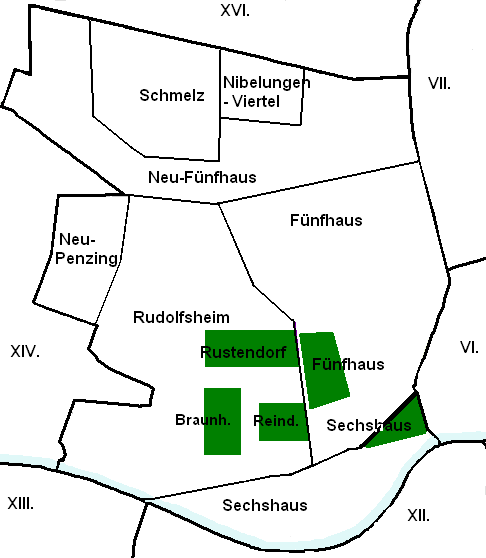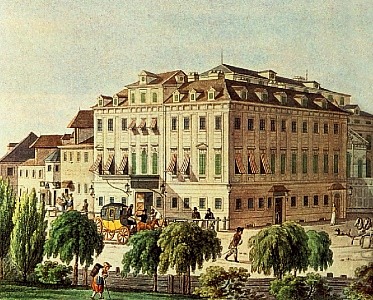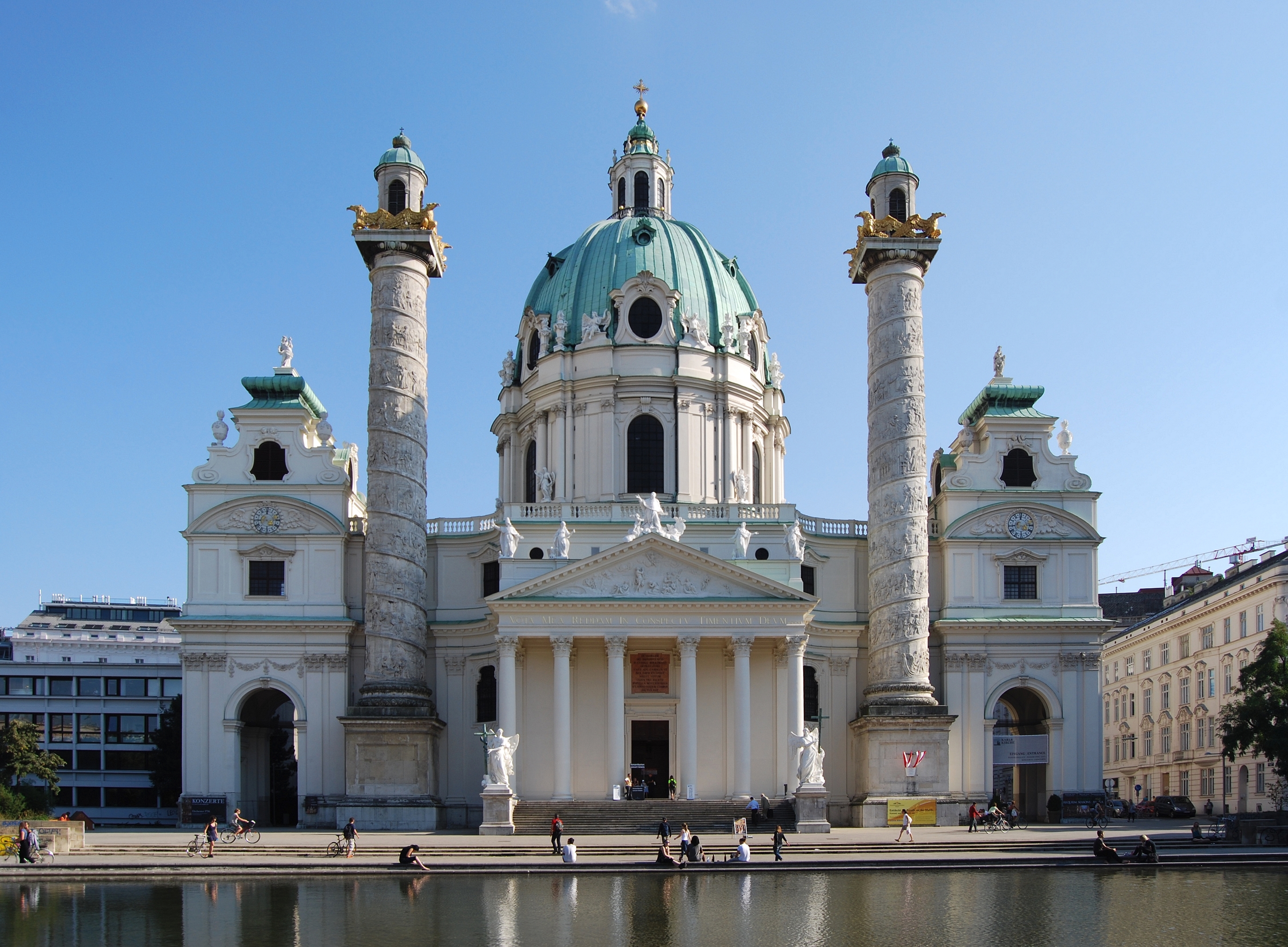|
Wienzeile
The Wienzeile ('Vienna Row') is a street in Vienna, which originated in the course of the regulation of the Vienna River between 1899 and 1905 along the river's banks. It is divided into the Rechte Wienzeile (Right Vienna Row) and the Linke Wienzeile (Left Vienna Row): * The Rechte Wienzeile runs through the Viennese districts of Wieden, Margareten, and Meidling and is so named after its position on the right bank of the Vienna River. * The Linke Wienzeile, located on the left bank of the Vienna River, runs through the Viennese districts of Mariahilf and Rudolfsheim-Fünfhaus. Before the regulation of the Vienna River, the Rechte Wienzeile was called ''Wienstraße'' in the fourth district, ''Flussgasse'' in the fifth district, ''An der Wien'', and ''Wienstraße''. The Linke Wienzeile had various names in the sixth district, first ''Am Wienufer'' as well as ''Ufergasse'', later ''Magdalenenstraße'' and ''Wienstraße''. The U-Bahn line U4 runs along the entirety of the Wienzeile's ... [...More Info...] [...Related Items...] OR: [Wikipedia] [Google] [Baidu] |
Vienna Secession
The Vienna Secession (german: Wiener Secession; also known as ''the Union of Austrian Artists'', or ''Vereinigung Bildender Künstler Österreichs'') is an art movement, closely related to Art Nouveau, that was formed in 1897 by a group of Austrian painters, graphic artists, sculptors and architects, including Josef Hoffman, Koloman Moser, Otto Wagner and Gustav Klimt. They resigned from the Association of Austrian Artists in protest against its support for more traditional artistic styles. Their most influential architectural work was the Secession Building designed by Joseph Maria Olbrich as a venue for expositions of the group. Their official magazine was called '' Ver Sacrum'' (''Sacred Spring'', in Latin), which published highly stylised and influential works of graphic art. In 1905 the group itself split, when some of the most prominent members, including Klimt, Wagner, and Hoffmann, resigned in a dispute over priorities, but it continued to function, and still functions ... [...More Info...] [...Related Items...] OR: [Wikipedia] [Google] [Baidu] |
Otto Wagner
Otto Koloman Wagner (; 13 July 1841 – 11 April 1918) was an Austrian architect, furniture designer and urban planner. He was a leading member of the Vienna Secession movement of architecture, founded in 1897, and the broader Art Nouveau movement. Many of his works are found in his native city of Vienna, and illustrate the rapid evolution of architecture during the period. His early works were inspired by classical architecture. By mid-1890s, he had already designed several buildings in what became known as the Vienna Secession style. Beginning in 1898, with his designs of Vienna Metro stations, his style became floral and Art Nouveau, with decoration by Koloman Moser. His later works, 1906 until his death in 1918, had geometric forms and minimal ornament, clearly expressing their function. They are considered predecessors to modern architecture. Education and early career Wagner was born in 1841 in Penzing, a district in Vienna. He was the son of Suzanne (née von Helf ... [...More Info...] [...Related Items...] OR: [Wikipedia] [Google] [Baidu] |
Mariahilf
Mariahilf (; Central Bavarian: ''Mariahüf'') is the 6th municipal district of Vienna, Austria (german: 6. Bezirk). It is near the center of Vienna and was established as a district in 1850. Mariahilf is a heavily populated urban area with many residential buildings. Wien.gv.at webpage (see below: References). Vienna Districts data, wien.gv.at, 2008, webpage: -->bezirksportraets08.pdf wien.gv.at-portraets08-PDF. It has a population of 31,621 (as of 2016-01-01) within an area of . Location Mariahilf is located southwest of Vienna's centre ( 1st district). In the north, Mariahilfer Straße, Vienna's most important shopping street, is its border with Neubau, in the south, the valley of the Vienna River, in the west, the Gürtel beltway. It consists of the five neighbourhoods (historical ''Vorstädte'', i.e. towns): Mariahilf, Gumpendorf, Windmühle, Magdalenengrund and Laimgrube. History First settlements around the Roman roads of the area developed around the year 1 ... [...More Info...] [...Related Items...] OR: [Wikipedia] [Google] [Baidu] |
Rudolfsheim-Fünfhaus
Rudolfsheim-Fünfhaus () is the 15th municipal District of Vienna, Austria (german: 15. Bezirk). It is in central Vienna, west of Innere Stadt. It borders Neubau and Mariahilf in the east, Meidling and Hietzing in the south, Penzing in the west, and Ottakring in the north. The northern border runs along the Gablenzgasse and eastern border along the Gürtel beltway (Neubaugürtel, Mariahilfer Gürtel and Sechshauser Gürtel). It includes the areas of Rudolfsheim (divided into Braunhirschen, Reindorf and Rustendorf), Fünfhaus and Sechshaus.Wien.gv.at webpage (see below: References).Vienna Districts data, wien.gv.at, 2008, webpagewien.gv.at-portraets08-PDF. Geography Topography The district area of Rudolfsheim-Fünfhaus was, during the Mesozoic Era, near a sea that retreated 70 million years ago and gradually formed an inland sea. After the final retreat of the sea occurred during the Ice Age, large masses of debris formed from glaciers, mainly from the Danube, but also the Vi ... [...More Info...] [...Related Items...] OR: [Wikipedia] [Google] [Baidu] |
Wiener Stadtbahn
The Vienna Stadtbahn (german: Wiener Stadtbahn) was a rail-based public transportation system operated under this name from 1898 until 1989. Today, the Vienna U-Bahn lines U4 and U6 and the Vienna S-Bahn (commuter rail) run on its former lines. The Stadtbahn is one of Vienna's better-known examples of early Art Nouveau architecture. Its most famous buildings are the two former station entrances on Karlsplatz, now used as a café and a museum respectively, and the ''Hofpavillon'', a station built specifically for Emperor Franz Joseph, located at the eastern end of Hietzing station. Other preserved historical stations are the elevated stations along the Gürtel and in some of the suburbs. The use of the term ''Stadtbahn'' in the line's name derives from the 19th century usage of the term to simply mean a railway in an urban area, in a similar way to the naming of the roughly contemporaneous Berlin Stadtbahn. It is not related to the usage of the term stadtbahn in post-World War I ... [...More Info...] [...Related Items...] OR: [Wikipedia] [Google] [Baidu] |
Naschmarkt
The Naschmarkt is Vienna's most popular market. Located at the Wienzeile over the Wien River, it is about long. The Naschmarkt has existed since the 16th century when mainly milk bottles were sold (as milk bottles were made out of ash (wood from an ash tree), "Asch" (German for "ash") led to the name "Aschenmarkt"). From 1793 onwards, all fruits and vegetables brought to Vienna with carts had to be sold there, while goods arriving on the Danube were sold elsewhere. Nowadays, one can buy fresh fruit and vegetables from around the world, exotic herbs, cheese, baked goods such as bread, kaiser rolls, torte, meats, and seafood. There are also many small restaurants which offer e.g. sushi, kebab, seafood, traditional Viennese food such as Kaiserschmarrn or Palatschinken (rolled up crepes) and stalls which offer clothes and accessories. Since 1977, the market extends further along the Wienzeile to an adjacent area every Saturday, when a flea market takes place there. The atmosphere of ... [...More Info...] [...Related Items...] OR: [Wikipedia] [Google] [Baidu] |
Theater An Der Wien
The is a historic theatre in Vienna located on the Left Wienzeile in the Mariahilf district. Completed in 1801, the theatre has hosted the premieres of many celebrated works of theatre, opera, and symphonic music. Since 2006, it has served primarily as an opera house, hosting its own company. Although "" is German for "Vienna", the "" in the name of the theatre is actually the name of the Wien River, which once flowed by the theatre site; "" means "on the banks of the Wien". In modern times, the river has been covered over in this location and the covered riverbed now houses the Naschmarkt, an open-air market. The theatre is operated in cooperation with Vereinigte Bühnen Wien (VBW) which also operates the Raimund Theater and the . History Early history The theatre was the brainchild of the Viennese theatrical impresario Emanuel Schikaneder, who is best known as Mozart's librettist and collaborator on the opera ''The Magic Flute'' (1791). Schikaneder's troupe had already ... [...More Info...] [...Related Items...] OR: [Wikipedia] [Google] [Baidu] |
Wieden
Wieden (; Central Bavarian: ''Wiedn'') is the 4th municipal district of Vienna, Austria (german: 4. Bezirk). It is near the centre of Vienna and was established as a district in 1850, but its borders were changed later. Wieden is a small region near the city centre. Wien.gv.at webpage (see below: References). After World War II, Wieden was part of the Soviet sector of Vienna for 10 years. __TOC__ History The name Wieden was first recorded in 1137, and is thus the oldest '' Vorstadt'' (former municipality within the ''Linienwall'') of Vienna. The main street ( Wiedner Hauptstraße) is certainly even older. The district was the site of the former royal Summer residence, which was completed under Ferdinand II, and was expanded many times until Maria Theresa sold it to the Jesuits. Today it is the Theresianum, a prestigious private boarding school, while the Diplomatic Academy of Vienna resides in a wing of the building. In the beginning of the 18th century, the development o ... [...More Info...] [...Related Items...] OR: [Wikipedia] [Google] [Baidu] |
Meidling
Meidling () is the 12th district of Vienna (german: 12. Bezirk, Meidling). It is located just southwest of the central districts, south of the Wienfluss, west of the Gürtel belt, and east and southeast of Schönbrunn palace. Meidling is a heavily populated urban area with many residential buildings, but also large recreational areas and parks. Vienna Districts data, wien.gv.at, 2008, webpage: wien.gv.at-portraets08-PDF. Wien.gv.at webpage (see below: References). In sports, it is represented by the FC Dynamo Meidling. Former Chancellor of Austria Sebastian Kurz was raised in Meidling and his private residence is there. Geography Location The 12th District lies in southwest Vienna, about 5–10 km (3–6 mi) from the Innere Stadt. It stretches from Wiental south of the Vienna River in the region between the Wienerberg hill in the 10th District and the Grünen Berg hill, of Schönbrunn Castle in the 13th District. District parts The former suburb, after which ... [...More Info...] [...Related Items...] OR: [Wikipedia] [Google] [Baidu] |
U-Bahn Wien
The Vienna U-Bahn (german: U-Bahn Wien), where ''U-Bahn'' is an abbreviation of the German term ''Untergrundbahn'' ( en, underground railway), is a rapid transit system serving Vienna, Austria. With the September 2017 opening of the , five-station extension of the U1 line, the five-line U-Bahn network consists of of route, serving 109 stations. It is the backbone of one of the best performing public transport systems worldwide according to UITP (International Association of Public Transport) in June 2009.Hödl, J: ''Das Wiener U-Bahn-Netz'', Wiener Linien, 2009. More than 1.3 million passengers rode the Vienna U-Bahn every day in 2009, and 567.6 million passengers used the U-Bahn in 2011, which declined to 428.8 million passengers in 2013. The network is undergoing expansion and rolling stock renewal. Since 1969, 200 million euros have been invested annually in the extension of the Vienna U-Bahn. The modern U-Bahn opened on 25 February 1978 (after test operations began on 8 May ... [...More Info...] [...Related Items...] OR: [Wikipedia] [Google] [Baidu] |
Vienna
en, Viennese , iso_code = AT-9 , registration_plate = W , postal_code_type = Postal code , postal_code = , timezone = CET , utc_offset = +1 , timezone_DST = CEST , utc_offset_DST = +2 , blank_name = Vehicle registration , blank_info = W , blank1_name = GDP , blank1_info = € 96.5 billion (2020) , blank2_name = GDP per capita , blank2_info = € 50,400 (2020) , blank_name_sec1 = HDI (2019) , blank_info_sec1 = 0.947 · 1st of 9 , blank3_name = Seats in the Federal Council , blank3_info = , blank_name_sec2 = GeoTLD , blank_info_sec2 = .wien , website = , footnotes = , image_blank_emblem = Wien logo.svg , blank_emblem_size = Vienna ( ; german: Wien ; ba ... [...More Info...] [...Related Items...] OR: [Wikipedia] [Google] [Baidu] |
Streets In Vienna
Streets is the plural of street, a type of road. Streets or The Streets may also refer to: Music * Streets (band), a rock band fronted by Kansas vocalist Steve Walsh * ''Streets'' (punk album), a 1977 compilation album of various early UK punk bands * '' Streets...'', a 1975 album by Ralph McTell * '' Streets: A Rock Opera'', a 1991 album by Savatage * "Streets" (song) by Doja Cat, from the album ''Hot Pink'' (2019) * "Streets", a song by Avenged Sevenfold from the album ''Sounding the Seventh Trumpet'' (2001) * The Streets, alias of Mike Skinner, a British rapper * "The Streets" (song) by WC featuring Snoop Dogg and Nate Dogg, from the album ''Ghetto Heisman'' (2002) Other uses * ''Streets'' (film), a 1990 American horror film * Streets (ice cream), an Australian ice cream brand owned by Unilever * Streets (solitaire), a variant of the solitaire game Napoleon at St Helena * Tai Streets (born 1977), American football player * Will Streets (1886–1916), English soldier and poe ... [...More Info...] [...Related Items...] OR: [Wikipedia] [Google] [Baidu] |





